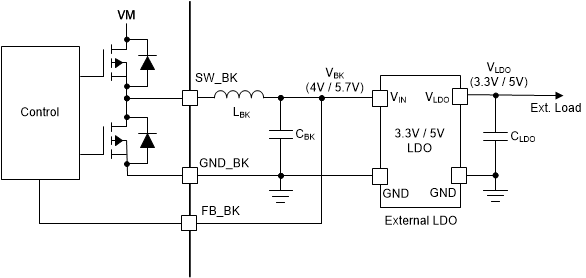SLLSFU1A December 2023 – July 2024 MCF8315C
PRODMIX
- 1
- 1 Features
- 2 Applications
- 3 Description
- 4 Pin Configuration and Functions
- 5 Specifications
-
6 Detailed Description
- 6.1 Overview
- 6.2 Functional Block Diagram
- 6.3
Feature Description
- 6.3.1 Output Stage
- 6.3.2 Device Interface
- 6.3.3 Step-Down Mixed-Mode Buck Regulator
- 6.3.4 AVDD Linear Voltage Regulator
- 6.3.5 Charge Pump
- 6.3.6 Slew Rate Control
- 6.3.7 Cross Conduction (Dead Time)
- 6.3.8 Motor Control Input Sources
- 6.3.9 Starting the Motor Under Different Initial Conditions
- 6.3.10 Motor Start Sequence (MSS)
- 6.3.11 Motor Start-up
- 6.3.12 Closed Loop Operation
- 6.3.13 Motor Parameters
- 6.3.14 Motor Parameter Extraction Tool (MPET)
- 6.3.15 Anti-Voltage Surge (AVS)
- 6.3.16 Active Braking
- 6.3.17 Output PWM Switching Frequency
- 6.3.18 PWM Modulation Schemes
- 6.3.19 Dead Time Compensation
- 6.3.20 Motor Stop Options
- 6.3.21 FG Configuration
- 6.3.22 DC Bus Current Limit
- 6.3.23
Protections
- 6.3.23.1 VM Supply Undervoltage Lockout
- 6.3.23.2 AVDD Undervoltage Lockout (AVDD_UV)
- 6.3.23.3 BUCK Under Voltage Lockout (BUCK_UV)
- 6.3.23.4 VCP Charge Pump Undervoltage Lockout (CPUV)
- 6.3.23.5 Overvoltage Protection (OVP)
- 6.3.23.6 Overcurrent Protection (OCP)
- 6.3.23.7 Buck Overcurrent Protection
- 6.3.23.8 Hardware Lock Detection Current Limit (HW_LOCK_ILIMIT)
- 6.3.23.9 Motor Lock (MTR_LCK)
- 6.3.23.10 Motor Lock Detection
- 6.3.23.11 Minimum VM (undervoltage) Protection
- 6.3.23.12 Maximum VM (overvoltage) Protection
- 6.3.23.13 MPET Faults
- 6.3.23.14 IPD Faults
- 6.3.23.15 Thermal Warning (OTW)
- 6.3.23.16 Thermal Shutdown (TSD)
- 6.4 Device Functional Modes
- 6.5 External Interface
- 6.6 EEPROM access and I2C interface
- 7 EEPROM (Non-Volatile) Register Map
- 8 RAM (Volatile) Register Map
- 9 Application and Implementation
- 10Device and Documentation Support
- 11Revision History
- 12Mechanical, Packaging, and Orderable Information
Package Options
Mechanical Data (Package|Pins)
Thermal pad, mechanical data (Package|Pins)
Orderable Information
6.3.3.3 Buck Regulator with External LDO
The buck regulator also supports the voltage requirement to supply an external LDO to generate standard 3.3V or 5V output rail with higher accuracies. The buck output voltage should be configured to 4V or 5.7V to provide extra headroom to support the external LDO for generating 3.3V or 5V rail as shown in Figure 6-5. This allows for a lower-voltage LDO design to save cost and better thermal management due to low drop-out voltage.
 Figure 6-5 Buck Regulator with External LDO
Figure 6-5 Buck Regulator with External LDO